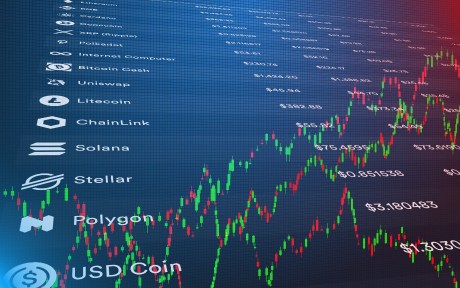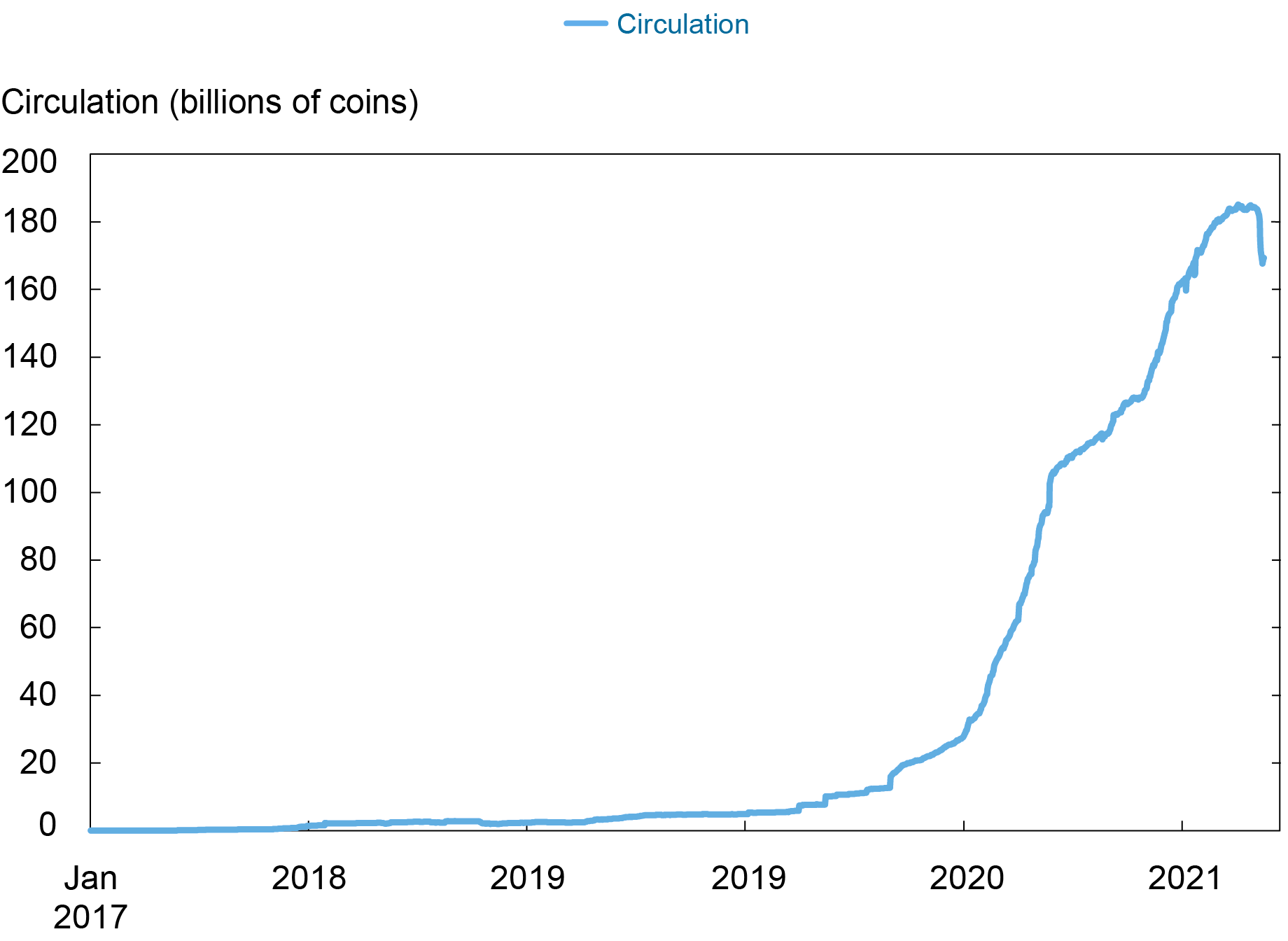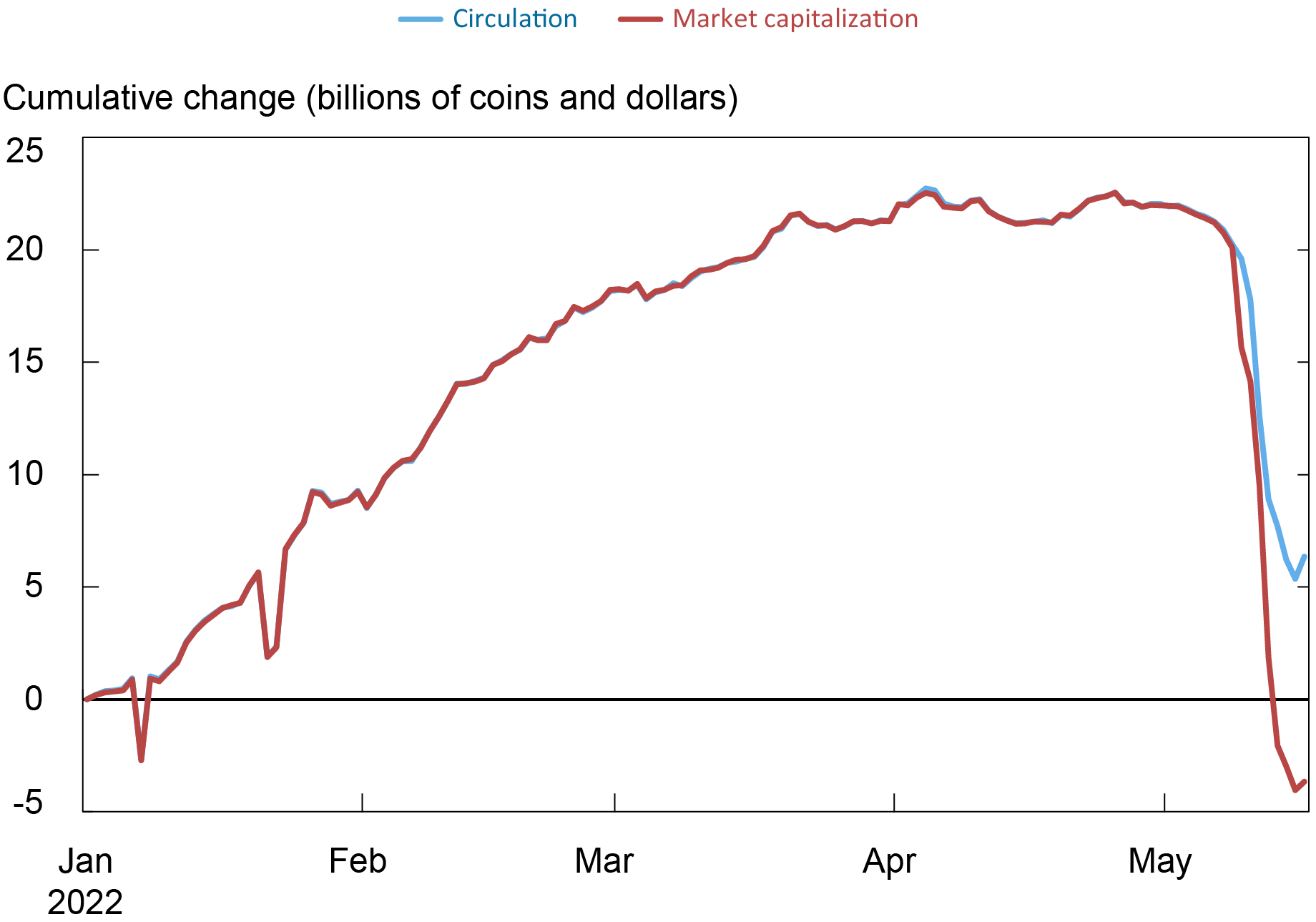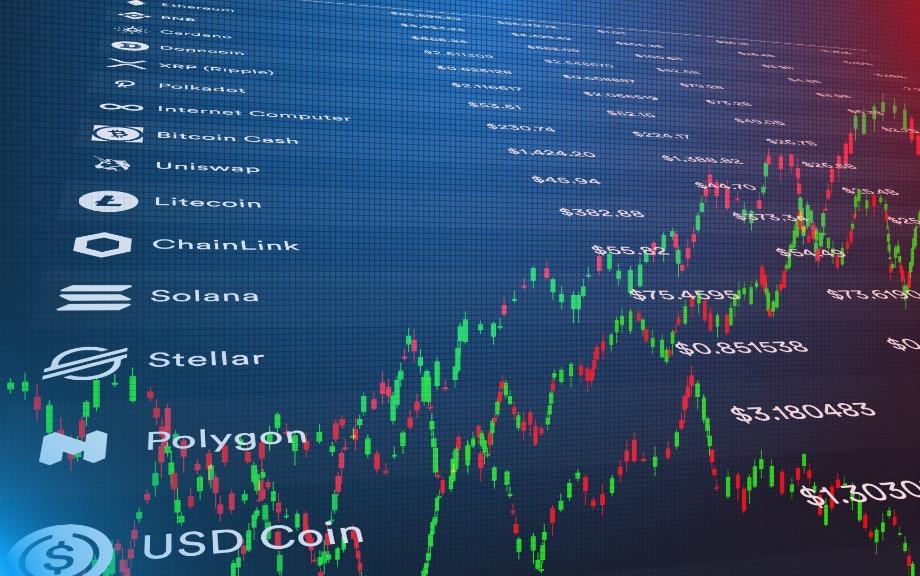Kenechukwu Anadu, Pablo D. Azar, Marco Cipriani, Thomas Eisenbach, Catherine Huang, Mattia Landoni, Gabriele La Spada, Marco Macchiavelli, Antoine Malfroy-Camine, and J. Christina Wang

Stablecoins are digital property whose worth is pegged to that of fiat currencies, often the U.S. greenback, with a typical alternate charge of 1 greenback per unit. Their market capitalization has grown exponentially over the past couple of years, from $5 billion in 2019 to round $180 billion in 2022. However their title, nevertheless, stablecoins may be very unstable: between Could 1 and Could 16, 2022, there was a run on stablecoins, with their circulation lowering by 15.58 billion and their market capitalization dropping by $25.63 billion (see charts under.) On this publish, we describe the several types of stablecoins and the way they hold their peg, examine them with cash market funds—an identical however a lot older and extra regulated monetary product, and talk about the stablecoin run of Could 2022.
Stablecoin Circulation Has Been Growing since 2019, however Dropped Sharply in Could 2022

Stablecoin Circulation and Market Capitalization in 2022

The Completely different Varieties of Stablecoins
Stablecoins use completely different mechanisms to peg their worth. The highest 4 stablecoins by market capitalization are Tether (USDT), USD Coin (USDC), Dai (DAI), and Binance USD (BUSD). Amongst these, USDT, USDC, and BUSD are ostensibly backed by conventional monetary property. A part of the backing of USDT is comprised of U.S. Treasury payments and company bonds, but additionally consists of comparatively dangerous property equivalent to valuable metals. In distinction, USDC and BUSD are backed by money deposited in U.S. banks, short-term U.S. Treasury payments, and different comparatively low-risk property equivalent to reverse repo contracts collateralized by U.S. treasuries. Furthermore, the issuers of USDC and BUSD are primarily based in america and controlled by U.S. authorities, in contrast to the issuer of USDT, which isn’t primarily based in america.
Stablecoins backed by conventional monetary property resemble the construction of cash market mutual funds (MMFs). Customers can mint new cash by depositing {dollars} with the issuer. When customers need to withdraw their {dollars}, they ship their stablecoins again to the issuer, who returns {dollars} to customers’ financial institution accounts. To make sure, there are essential variations. First, MMFs are regulated by the Securities and Change Fee below Rule 2a-7, which units minimal portfolio liquidity and maturity requirements, amongst different issues, whereas stablecoins will not be. Second, stablecoins are traded on a number of exchanges, whereas MMF shares will not be traded on exchanges. Lastly, stablecoin models can be utilized as collateral in decentralized finance protocols, growing the interconnection between completely different blockchain functions, whereas tokenization of MMF shares is nascent.
Different stablecoins, in distinction, are backed by risky cryptoassets; DAI, as an illustration, may be backed by Ether, the native cryptocurrency of the decentralized, open-source blockchain Ethereum. To ensure that the peg to be credible, each greenback of DAI is backed by a couple of greenback price of Ether; that’s, DAI is overcollateralized. One other essential characteristic of DAI is that it’s decentralized: DAI may be created by depositing collateral in good contracts, that are packages executed by miners on a blockchain (Ethereum within the case of DAI) that run when predetermined situations are met. With a view to mint DAI, an investor deposits the collateral within the good contract; to be able to redeem DAI, the investor deposits the DAI within the good contract and receives again the collateral. Importantly, if the worth of the collateral drops under the minimal collateralization degree required by the contract, any person can name a operate on the contract to liquidate the collateral by means of an public sale and obtain a share of the collateral as a reward. This characteristic makes DAI very completely different from the stablecoins described above and in addition from MMFs. Along with Ether, DAI may be backed by different cryptoassets together with Bitcoin, USDC, and, extra just lately, tokenized mortgages, with MakerDAO—the decentralized autonomous group regulating and sustaining DAI—setting the required degree of collateralization for every asset.
A 3rd sort of stablecoin, algorithmic stablecoins, are backed by an algorithmic mechanism that’s supposed to keep up the peg. Essentially the most distinguished algorithmic stablecoin was Terra, which at its peak had a market capitalization of over $18 billion. The builders of Terra created two cryptoassets: TerraUSD (UST)—designed to be secure—and Luna—designed to fluctuate over time, equally to Bitcoin. Any investor in Terra had entry to a wise contract that allowed them to create or redeem one unit of UST for one greenback price of Luna. As an example, if the worth of Luna was $10, the good contract would alternate one Terra for 0.1 models of Luna. Due to this fact, regardless of the worth of Luna—so long as it was higher than zero—the worth of UST ought to have been $1 as a result of an arbitrage alternative. As an example, if the worth of UST dropped to 99 cents, merchants may revenue by shopping for UST and exchanging it for Luna—profiting 1 cent per token. Such arbitrage buying and selling would drive the worth of UST up as a result of a rise in demand and, on the identical time, cut back the provision because of the alternate of Terra tokens for Luna tokens. Conversely, if the worth of UST was at $1.01, arbitrageurs may revenue by shopping for $1 price of Luna, reworking into UST and acquiring $1.01, yielding a revenue of 1 cent.
This algorithmic mechanism, nevertheless, relied on buyers being keen to purchase Terra each time its value dropped under one; this was not at all times the case. Specifically, Terra redemptions elevated the provision of Luna. As the worth of Luna dropped because of the enhance in its provide, every greenback redeemed out of Terra triggered an excellent higher enhance of the provision of Luna. As an example, if Luna traded at $0.1, redeeming one unit of Terra would create ten models of Luna; but when Luna dropped to $0.01, redeeming one unit of Terra would create 100 models of Luna. In some unspecified time in the future, buyers could be unwilling to purchase Terra even when its value dropped under $1 as a result of it could be backed by an asset, Luna, whose value was quickly declining.
The Run on Terra
Certainly, that’s precisely what occurred in Could 2022. Terra, the fourth largest stablecoin on the time, suffered a run and a subsequent collapse, with its circulation dropping by virtually 8 billion and its market capitalization dropping by $18.47 billion by the tip of the month. As Terra suffered heavy redemptions, the provision of Luna elevated from 365 million models on Could 9, to greater than 6 trillion models by Could 13. Between Could 7 and Could 8, the algorithmic mechanism broke, and Terra broke the peg, with its value dropping from $0.9964 to $0.7934.
In a couple of week, between Could 7 and Could 16, the crash worn out $17.17 billion in Terra’s market worth and $20.77 billion in Luna’s market worth. The run rapidly propagated to different stablecoins, together with USDT and DAI. U.S.-based stablecoins backed by conventional protected monetary property, nevertheless, equivalent to USDC and BUSD, acquired important inflows throughout the identical interval as buyers moved from riskier stablecoins to much less dangerous ones. Specifically, circulation dropped by 8.70 billion models for algorithmic stablecoins and by 2.25 billion models for crypto-collateralized stablecoins; in distinction, the circulation of U.S.-based stablecoins elevated by 3.88 billion models. This dynamic is much like what we’ve got noticed in latest runs on the MMF business, when investments flowed from riskier prime funds to much less dangerous authorities funds. And as with MMF runs, stablecoin runs can propagate to broader asset lessons; the Could 2022 stablecoin run, as an illustration, affected the broader crypto market, with roughly $200 billion in crypto market worth (past stablecoins) being worn out over eight days.
Summing Up
In Could 2022, there was a run on Terra, an algorithmic stablecoin whose value broke its peg of $1 and crashed to zero. The run spilled over to all the stablecoin sector, with stablecoins backed by riskier property closely affected and buyers fleeing to much less dangerous U.S.-based stablecoins regulated by U.S. authorities. Because the digital asset ecosystem continues to develop, its potential to have an effect on conventional monetary markets and a broader part of households and corporations may develop accordingly.
Kenechukwu Anadu is vp on the Federal Reserve Financial institution of Boston.

Pablo Azar is a monetary analysis economist in Cash and Funds Research within the Federal Reserve Financial institution of New York’s Analysis and Statistics Group.

Marco Cipriani is the top of Cash and Funds Research within the Federal Reserve Financial institution of New York’s Analysis and Statistics Group.

Thomas M. Eisenbach is a monetary analysis advisor in Cash and Funds Research within the Federal Reserve Financial institution of New York’s Analysis and Statistics Group.

Catherine Huang is a analysis analyst within the Federal Reserve Financial institution of New York’s Analysis and Statistics Group.
Mattia Landoni is a senior monetary economist on the Federal Reserve Financial institution of Boston.

Gabriele La Spada is a monetary analysis economist in Cash and Funds Research within the Federal Reserve Financial institution of New York’s Analysis and Statistics Group.
Marco Macchiavelli is an assistant professor of finance at College of Massachusetts Amherst.
Antoine Malfroy-Camine is a senior threat analyst on the Federal Reserve Financial institution of Boston.
J. Christina Wang is a senior economist and coverage advisor on the Federal Reserve Financial institution of Boston.
Find out how to cite this publish:
Kenechukwu Anadu, Pablo D. Azar, Marco Cipriani, Thomas Eisenbach, Catherine Huang, Mattia Landoni, Gabriele La Spada, Marco Macchiavelli, Antoine Malfroy-Camine, and J. Christina Wang, “Runs on Stablecoins,” Federal Reserve Financial institution of New York Liberty Avenue Economics, July 12, 2023, https://libertystreeteconomics.newyorkfed.org/2023/07/runs-on-stablecoins/.
Disclaimer
The views expressed on this publish are these of the creator(s) and don’t essentially replicate the place of the Federal Reserve Financial institution of New York or the Federal Reserve System. Any errors or omissions are the duty of the creator(s).

